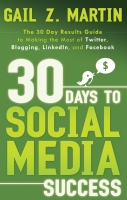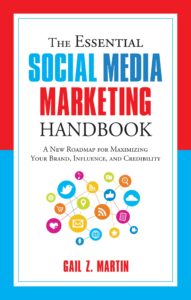 by Gail Z. Martin excerpted from 30 Days to Social Media Success
by Gail Z. Martin excerpted from 30 Days to Social Media Success
As you’re invited to be interviewed or be a guest blogger, create a spreadsheet of reporters and key contacts. This will come in handy as you ramp up your public relations efforts. I would suggest building your media list in a spreadsheet like Microsoft Excel to make it easy to view and update. Here are the key elements your media list should include:
- Reporter/blogger/host name
- Contact email (best if it is directly to the reporter/host and not a general “info” email)
- Phone number for follow up calls
- Web site
- Notes to help you target the right news to the right person.
It is absolutely essential that you have a name for the reporter/blogger/host you want to reach. Nothing turns off a reporter more than to get an email addressed to “Dear Sir or Madam” or “Dear Editor”. (By the way, unless it is the only contact person named and it’s a very small publication, don’t send your news to the publication’s editor. Find the individual reporter/blogger who handles that topic.) Remember that successful PR isn’t about blasting out releases to the largest list possible; instead, it’s about cultivating win-win relationships with gatekeepers and consumers who share your information because it is valuable to their audiences.
Without a contact email, you won’t be able to send your press release. I’m not a big fan of email forms on Web sites. I much prefer a real email address. However, if your only choice is a contact form and the site is a good match for your topic, send a preliminary email explaining your need and ask to whom you should send your information. Assuming someone is minding the store, you should get a response directing you to some other email used for press releases.
Phone numbers should be used sparingly. I’ve had many professional reporters and radio/TV hosts tell me that it takes a minimum of seven contacts to get a reporter’s attention. The majority of these contacts should come via email to be less intrusive. However, if you have sent your release and followed up several times via email, and it is an important newsworthy item (not just important to you, but to the target audience), then it’s OK to make a brief follow-up call. Give your name and company name, and no more than a one-sentence recap of the release, mentioning that you had emailed it and wanted to make sure it was received. Offer to re-send it if they did not receive it, and leave your name, phone number and email address. Don’t beg or threaten or go into sales mode. If your news appeals to them, they’re likely to call. If not, just assume that it wasn’t a good fit this time, and try again on the next release.
Visit the Web site to make sure that your topic hasn’t been recently featured, and to get a feel for the style and tone. Review what the site covers and the slant it takes to confirm that it is a good fit for your audience and this particular release. You don’t have to send every release to everyone on your media list. Build a reputation for being a good news source by only sending releases to the people most interested in the topic, and avoid cluttering up the inbox of reporters who won’t be interested (they’ll remember, and not in a good way).
In the “notes” section, jot information to help the next round of releases be more successful. For example, find out how often the site/blog updates with new material. If you missed the deadline this time, make a note of it for next time. If you have a conversation with a reporter/blogger via email or phone, write down what you learned about upcoming topics being researched and things they don’t cover at all. This will help you send the right material next time, which builds trust and credibility.
If the site has information that documents their target reader or listener, review it, but don’t believe everything you read. Unless the information is formally audited, there’s no way to know for sure. However, the way the site describes its audience should make sense given what you see on the site itself. Don’t base your choices on age and income alone. Be on the lookout for sites that really focus on your niche.
For really big news, send the release to a national audience. Compiling the list yourself is a large and time-consuming task. Media people change jobs frequently, so your list may be outdated by the next time you need it. I suggest paying the money to send out a national release via sites like PR Newswire. These sites are in business to send out releases successfully, and they have the manpower to keep their lists updated.
Remember that online PR must meet the needs of the consumer as well as the reporter. Make the news valuable enough to both move the reader to action and encourage the reader to share the information with his or her network of friends and followers. Focus on user benefit (without going into sales language) rather than listing features. If you have a special discount, promotion or bonus, make sure to mention it. Provide a link to the product page (which should have a “buy now” link) and not just to your home page. Make it easy for a consumer to consume your product!






